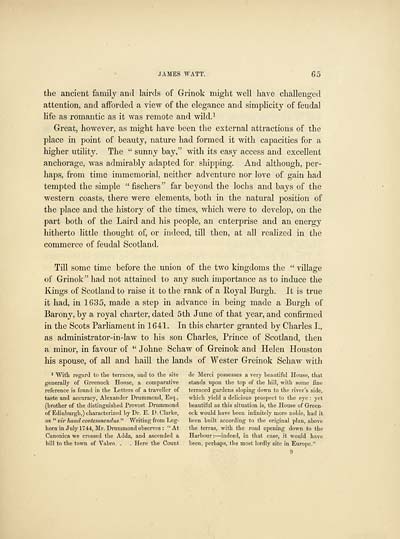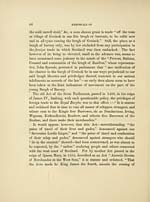Memorials of the lineage, early life, education and development of the genius of James Watt
(87) Page 65
Download files
Complete book:
Individual page:
Thumbnail gallery: Grid view | List view

JAMES WATT. 65
the ancient family and lairds of Grinok might well have challenged
attention, and afforded a view of the elegance and simplicity of feudal
life as romantic as it was remote and wild. 1
Great, however, as might have been the external attractions of the
place in point of beauty, nature had formed it with capacities for a
higher utility. The " sunny bay," with its easy access and excellent
anchorage, was admirably adapted for shipping. And although, per-
haps, from time immemorial, neither adventure nor love of gain had
tempted the simple " fischers" far beyond the lochs and bays of the
western coasts, there were elements, both in the natural position of
the place and the history of the times, which were to develop, on the
part both of the Laird and his people, an enterprise and an energy
hitherto little thought of, or indeed, till then, at all realized in the
commerce of feudal Scotland.
Till some time before the union of the two kingdoms the " village
of Grinok" had not attained to any such importance as to induce the
Kings of Scotland to raise it to the rank of a Royal Burgh. It is true
it had, in 1635, made a step in advance in being made a Burgh of
Baron} 7 , by a royal charter, dated 5th June of that year, and confirmed
in the Scots Parliament in 1 641. In this charter granted by Charles I.,
as administrator-in-law to his son Charles, Prince of Scotland, then
a minor, in favour of " Johne Schaw of Greinok and Helen Houston
his spouse, of all and haill the lands of "Wester Greinok Schaw with
1 With regard to the terraces, and to the site de Merci possesses a very beautiful House, that
generally of Greenock House, a comparative stands upon the top of the hill, with some fine
reference is found in the Letters of a traveller of terraced gardens sloping down to the river's side,
taste and accuracy, Alexander Drummond, Esq., which yield a delicious prospect to the eye : yet
(brother of the distinguished Provost Drummond beautiful as this situation is, the House of Green-
of Edinburgh,) characterized by Dr. E. D. Clarke, ock would have been infinitely more noble, had it
as " vir hand contemnendus." Writing from Leg- been built according to the original plan, above
horn in July 1744, Mr. Drummond observes : "At the terras, with the road opening down to the
Canonica we crossed the Adda, and ascended a Harbour : — indeed, in that case, it would have
hill to the town of Vabro. . . Here the Count been, perhaps, the most lordly site in Europe."
9
the ancient family and lairds of Grinok might well have challenged
attention, and afforded a view of the elegance and simplicity of feudal
life as romantic as it was remote and wild. 1
Great, however, as might have been the external attractions of the
place in point of beauty, nature had formed it with capacities for a
higher utility. The " sunny bay," with its easy access and excellent
anchorage, was admirably adapted for shipping. And although, per-
haps, from time immemorial, neither adventure nor love of gain had
tempted the simple " fischers" far beyond the lochs and bays of the
western coasts, there were elements, both in the natural position of
the place and the history of the times, which were to develop, on the
part both of the Laird and his people, an enterprise and an energy
hitherto little thought of, or indeed, till then, at all realized in the
commerce of feudal Scotland.
Till some time before the union of the two kingdoms the " village
of Grinok" had not attained to any such importance as to induce the
Kings of Scotland to raise it to the rank of a Royal Burgh. It is true
it had, in 1635, made a step in advance in being made a Burgh of
Baron} 7 , by a royal charter, dated 5th June of that year, and confirmed
in the Scots Parliament in 1 641. In this charter granted by Charles I.,
as administrator-in-law to his son Charles, Prince of Scotland, then
a minor, in favour of " Johne Schaw of Greinok and Helen Houston
his spouse, of all and haill the lands of "Wester Greinok Schaw with
1 With regard to the terraces, and to the site de Merci possesses a very beautiful House, that
generally of Greenock House, a comparative stands upon the top of the hill, with some fine
reference is found in the Letters of a traveller of terraced gardens sloping down to the river's side,
taste and accuracy, Alexander Drummond, Esq., which yield a delicious prospect to the eye : yet
(brother of the distinguished Provost Drummond beautiful as this situation is, the House of Green-
of Edinburgh,) characterized by Dr. E. D. Clarke, ock would have been infinitely more noble, had it
as " vir hand contemnendus." Writing from Leg- been built according to the original plan, above
horn in July 1744, Mr. Drummond observes : "At the terras, with the road opening down to the
Canonica we crossed the Adda, and ascended a Harbour : — indeed, in that case, it would have
hill to the town of Vabro. . . Here the Count been, perhaps, the most lordly site in Europe."
9
Set display mode to:
![]() Universal Viewer |
Universal Viewer | ![]() Mirador |
Large image | Transcription
Mirador |
Large image | Transcription
Images and transcriptions on this page, including medium image downloads, may be used under the Creative Commons Attribution 4.0 International Licence unless otherwise stated. ![]()
| Histories of Scottish families > Memorials of the lineage, early life, education and development of the genius of James Watt > (87) Page 65 |
|---|
| Permanent URL | https://digital.nls.uk/95170498 |
|---|
| Description | A selection of almost 400 printed items relating to the history of Scottish families, mostly dating from the 19th and early 20th centuries. Includes memoirs, genealogies and clan histories, with a few produced by emigrant families. The earliest family history goes back to AD 916. |
|---|

